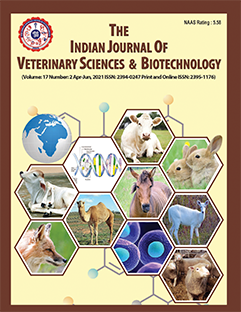Prevalence of Canine Gastrointestinal Helminths and Molecular Confirmation of Toxocara canis
DOI:
https://doi.org/10.48165/ijvsbt.21.4.16Keywords:
Canine gastrointestinal helminths, Polymerase chain reaction, Prevalence, Toxocara canisAbstract
The present study was carried out to assess the prevalence of various canine gastro-intestinal (GI) helminths in animal population and soil in and around Tirupati city of Andhra Pradesh (India), and to confirm Toxocara canis at molecular level through Polymerase Chain Reaction. A total of 196 faecal and 111 soil samples were collected and examined. The overall prevalence of canine GI helminths among animal population and soil was 54.08% and 41.44%, respectively. The faecal samples were confirmed with 4 canine GI nematodes, viz.,
Ancylostoma spp. (20.41%), Toxocara canis (16.84%), Strongyloides stercoralis (5.61%), Trichuris vulpis (3.06%) and, one canine GI cestode, viz., Dipylidium caninum (3.57%) and combinations of Ancylostoma spp., Toxocara canis, Strongyloides stercoralis (4.59%), while the soil samples had Toxocara canis (19.81%), Ancylostoma spp. (14.14%), Strongyloides stercoralis (5.40%) and Trichuris vulpis (1.80%). Location wise, the prevalence of soil transmitted canine GI helminths was the highest in public parks (46.60%) followed by veterinary dispensaries/ hospitals (44.40%), school grounds (40.00%) and temple surroundings (12.50%). The amplification of genomic DNA (extracted from adult worms and eggs of Toxocara canis) through PCR targeting the Internal Transcribed Spacer-2 region of ribosomal DNA and subsequent gel documentation exhibited a ~540 bp product confirming the Toxocara canis.
Downloads
References
Ahmad, P. A., Rohini, S., Katoch, S., Anish, Y., Godara, R., & Rafiqui, S. I. (2018). Incidence of gastrointestinal helminths of stray dogs: A post-mortem study. The Haryana Veterinarian, 57(2), 222–223.
Charitha, V. G. (2018). Detection and molecular characterization of soil transmitted helminths of zoonotic significance in Andhra Pradesh (PhD Thesis). Sri Venkateswara Veterinary University, Tirupati, India.
Chen, J., Zhou, D. H., Nisbet, A. J., Xu, M. J., Huang, S. Y., Li, M. W., Wang, C. R., & Zhu, X. Q. (2012). Advances in molecular identification, taxonomy, genetic variation and diagnosis of Toxocara species. Infection, Genetics and Evolution, 12, 1344–1348.
Cruz, A. T., Franklin, G. Y., & Kaplan, S. L. (2008). Toxocariasis causing eosinophilic ascites. Pediatric Infectious Disease Journal, 27, 563–564.
Fowler, C. (2025). 14 India pet ownership statistics to know in 2025. Dogster. https://www.dogster.com/statistics/pet-ownership-statistics-india
Katagiri, S., & Oliveira, T. C. (2008). Prevalence of dog intestinal parasites and risk perception of zoonotic infection by dog owners in Sao Paulo state, Brazil. Zoonoses Public Health, 55, 406–413.
Kaur, J., Gupta, A., & Wadhwa, N. (2017). Hepatic visceral larva migrans causing hepatic venous thrombosis and prolonged fever. Indian Pediatrics, 54, 882–884.
Khademvatan, S., Rahim, F., Tavalla, M., Abdizadeh, R., & Hashemitabar, M. (2013). PCR-based molecular characterization of Toxocara spp. using faeces of stray cats: A study from southwest Iran. PLoS One, 8(2), e0000001.
Lorcain, P. O. (1994). Prevalence of Toxocara canis ova in public playgrounds in the Dublin area of Ireland. Journal of Helminthology, 68, 237–241.
Moudgil, A. D., Mittra, S., Agnihotri, R. K., Sharma, D., & Sen, D. (2016). Prevalence of gastrointestinal parasites in dogs of Palampur, Himachal Pradesh. Journal of Parasitic Diseases, 40(2), 227–229.
Moura, F. T., Falavigna, D. L. M., Mota, L. T., & Toledo, M. J. O. (2010). Enteroparasite contamination in peridomiciliar soils of two indigenous territories, State of Parana, southern Brazil. Revista Panamericana de Salud Publica, 27(6), 2–16.
Mukaratirwa, S., & Singh, V. P. (2010). Prevalence of gastrointestinal parasites of stray dogs impounded by the SPCA, Durban and Coast, South Africa. Journal of the South African Veterinary Association, 81(2), 123–125.
Papaiakovou, M., Pilotte, N., Baumer, B., Grant, J., Asbjornsdottir, K., Schaer, F., Hu, Y., Aroian, R., Walson, J., & Williams, S. A. (2018). A comparative analysis of preservation techniques for the optimal molecular detection of hookworm DNA in a human fecal specimen. PLoS Neglected Tropical Diseases, 12(1), e0006130.
Qadir, S., Dixit, A. K., & Dixit, P. (2012). Prevalence and intensity of canine gastrointestinal helminths in Jabalpur, Madhya Pradesh. Journal of Veterinary Parasitology, 26(1), 23–26.
Qadri, S. M. (2008). Soil transmitted helminthic infections in children and its impact on their health in India (Master’s Thesis). Royal Tropical Institute, Amsterdam.
Roja, K., Sreedevi, C., Malakondaiah, P., & Sudhakar, K. (2019). Prevalence and risk factors associated with gastrointestinal parasitic infection in dogs from central coastal districts, Andhra Pradesh with special reference to anthelminthic resistance (Master’s Thesis). Sri Venkateswara Veterinary University, Tirupati, India.
Sambrook, J., & Russel, D. W. (2001). Molecular cloning: A laboratory manual (3rd ed.). Cold Spring Harbor Laboratory Press.
Sharma, S. K., Sinha, S. R. P., Sinha, S., Kumar, L., & Mahtha, R. K. (2006). Gastrointestinal helminthic parasites and treatment in different breeds of dogs. Indian Veterinary Journal, 83, 834–836.
Singh, H., Haque, M., Singh, N. K., & Rath, S. S. (2012). Occurrence of parasitic infections in dogs in and around Ludhiana, Punjab (India). Applied Biological Research, 14(1), 108–110.
Song, S. J., Amir, A., Metcalf, J. L., Amato, K. R., Xu, Z. Z., Humphrey, G., & Knight, R. (2016). Preservation methods differ in fecal microbiome stability, affecting suitability for field studies. mSystems, 1(3), e00021-16.
Sudan, V., Jaiswal, A. K., Shanker, D., Kanojiya, D., & Sachan, A. (2013). Prevalence of endoparasitic infections of non-descript dogs in Mathura, Uttar Pradesh. Journal of Parasitic Diseases, 39(3), 491–494.
Thakkar, P. A., Dahat, A., Shukla, O., & Javadekar, S. (2012). An interesting case of visceral larva migrans (VLM). International Journal of Medical Science and Public Health, 1, 101–104.
Vatsya, S., Garg, R., Kumar, R. R., Yadav, C. L., & Banerjee, P. S. (2010). Retrospective study on the incidence of gastrointestinal and blood parasites in dogs at Pantnagar and their public health significance. Journal of Veterinary Public Health, 8(1), 29–32.
Downloads
Published
Issue
Section
License
Copyright (c) 2025 Indian Journal of Veterinary Sciences and Biotechnology

This work is licensed under a Creative Commons Attribution-NonCommercial-NoDerivatives 4.0 International License.




